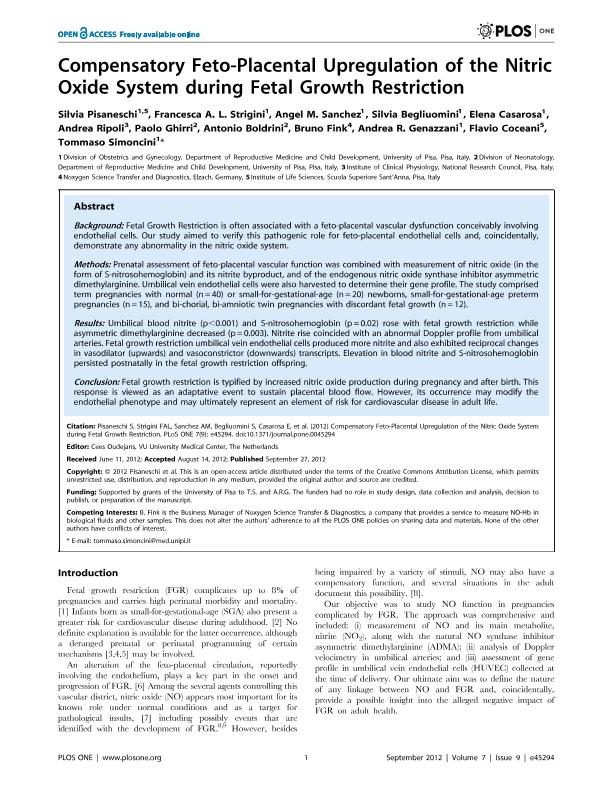Mostrar el registro sencillo del ítem
dc.contributor.author
Pisaneschi, Silvia
dc.contributor.author
Strigini, Francesca A. L.
dc.contributor.author
Sanchez, Angel Matias

dc.contributor.author
Begliuomini, Silvia
dc.contributor.author
Casarosa, Elena
dc.contributor.author
Ripoli, Andrea
dc.contributor.author
Ghirri, Paolo
dc.contributor.author
Boldrini, Antonio
dc.contributor.author
Fink, Bruno
dc.contributor.author
Genazzani, Andrea R.
dc.contributor.author
Coceani, Flavio
dc.contributor.author
Simoncini, Tommaso
dc.date.available
2019-07-26T14:25:26Z
dc.date.issued
2012-09
dc.identifier.citation
Pisaneschi, Silvia; Strigini, Francesca A. L.; Sanchez, Angel Matias; Begliuomini, Silvia; Casarosa, Elena; et al.; Compensatory Feto-Placental Upregulation of the Nitric Oxide System during Fetal Growth Restriction; Public Library of Science; Plos One; 7; 9; 9-2012; 1-9; e45294
dc.identifier.issn
1932-6203
dc.identifier.uri
http://hdl.handle.net/11336/80368
dc.description.abstract
Background: Fetal Growth Restriction is often associated with a feto-placental vascular dysfunction conceivably involving endothelial cells. Our study aimed to verify this pathogenic role for feto-placental endothelial cells and, coincidentally, demonstrate any abnormality in the nitric oxide system. Methods: Prenatal assessment of feto-placental vascular function was combined with measurement of nitric oxide (in the form of S-nitrosohemoglobin) and its nitrite byproduct, and of the endogenous nitric oxide synthase inhibitor asymmetric dimethylarginine. Umbilical vein endothelial cells were also harvested to determine their gene profile. The study comprised term pregnancies with normal (n = 40) or small-for-gestational-age (n = 20) newborns, small-for-gestational-age preterm pregnancies (n = 15), and bi-chorial, bi-amniotic twin pregnancies with discordant fetal growth (n = 12). Results: Umbilical blood nitrite (p<0.001) and S-nitrosohemoglobin (p = 0.02) rose with fetal growth restriction while asymmetric dimethylarginine decreased (p = 0.003). Nitrite rise coincided with an abnormal Doppler profile from umbilical arteries. Fetal growth restriction umbilical vein endothelial cells produced more nitrite and also exhibited reciprocal changes in vasodilator (upwards) and vasoconstrictor (downwards) transcripts. Elevation in blood nitrite and S-nitrosohemoglobin persisted postnatally in the fetal growth restriction offspring. Conclusion: Fetal growth restriction is typified by increased nitric oxide production during pregnancy and after birth. This response is viewed as an adaptative event to sustain placental blood flow. However, its occurrence may modify the endothelial phenotype and may ultimately represent an element of risk for cardiovascular disease in adult life.
dc.format
application/pdf
dc.language.iso
eng
dc.publisher
Public Library of Science

dc.rights
info:eu-repo/semantics/openAccess
dc.rights.uri
https://creativecommons.org/licenses/by-nc-sa/2.5/ar/
dc.subject
Fetal Growth Restriction
dc.subject
Nitric Oxide System
dc.subject
S- Nitrosohemoglobin
dc.subject
Endothelial Cells
dc.subject.classification
Obstetricia y Ginecología

dc.subject.classification
Medicina Clínica

dc.subject.classification
CIENCIAS MÉDICAS Y DE LA SALUD

dc.title
Compensatory Feto-Placental Upregulation of the Nitric Oxide System during Fetal Growth Restriction
dc.type
info:eu-repo/semantics/article
dc.type
info:ar-repo/semantics/artículo
dc.type
info:eu-repo/semantics/publishedVersion
dc.date.updated
2019-06-10T21:22:00Z
dc.journal.volume
7
dc.journal.number
9
dc.journal.pagination
1-9; e45294
dc.journal.pais
Estados Unidos

dc.journal.ciudad
San Francisco
dc.description.fil
Fil: Pisaneschi, Silvia. Università degli Studi di Pisa; Italia. Scuola Superiore Sant’Anna; Italia
dc.description.fil
Fil: Strigini, Francesca A. L.. Università degli Studi di Pisa; Italia
dc.description.fil
Fil: Sanchez, Angel Matias. Università degli Studi di Pisa; Italia. Consejo Nacional de Investigaciones Científicas y Técnicas. Centro Científico Tecnológico Conicet - Mendoza. Instituto de Medicina y Biología Experimental de Cuyo; Argentina
dc.description.fil
Fil: Begliuomini, Silvia. Università degli Studi di Pisa; Italia
dc.description.fil
Fil: Casarosa, Elena. Università degli Studi di Pisa; Italia
dc.description.fil
Fil: Ripoli, Andrea. National Research Council. Institute of Clinical Physiology, ; Italia
dc.description.fil
Fil: Ghirri, Paolo. Università degli Studi di Pisa; Italia
dc.description.fil
Fil: Boldrini, Antonio. Università degli Studi di Pisa; Italia
dc.description.fil
Fil: Fink, Bruno. Noxygen Science Transfer and Diagnostics; Alemania
dc.description.fil
Fil: Genazzani, Andrea R.. Università degli Studi di Pisa; Italia
dc.description.fil
Fil: Coceani, Flavio. Scuola Superiore Sant’Anna; Italia
dc.description.fil
Fil: Simoncini, Tommaso. Università degli Studi di Pisa; Italia
dc.journal.title
Plos One

dc.relation.alternativeid
info:eu-repo/semantics/altIdentifier/doi/http://dx.doi.org/10.1371/journal.pone.0045294
dc.relation.alternativeid
info:eu-repo/semantics/altIdentifier/url/https://journals.plos.org/plosone/article?id=10.1371/journal.pone.0045294
Archivos asociados
